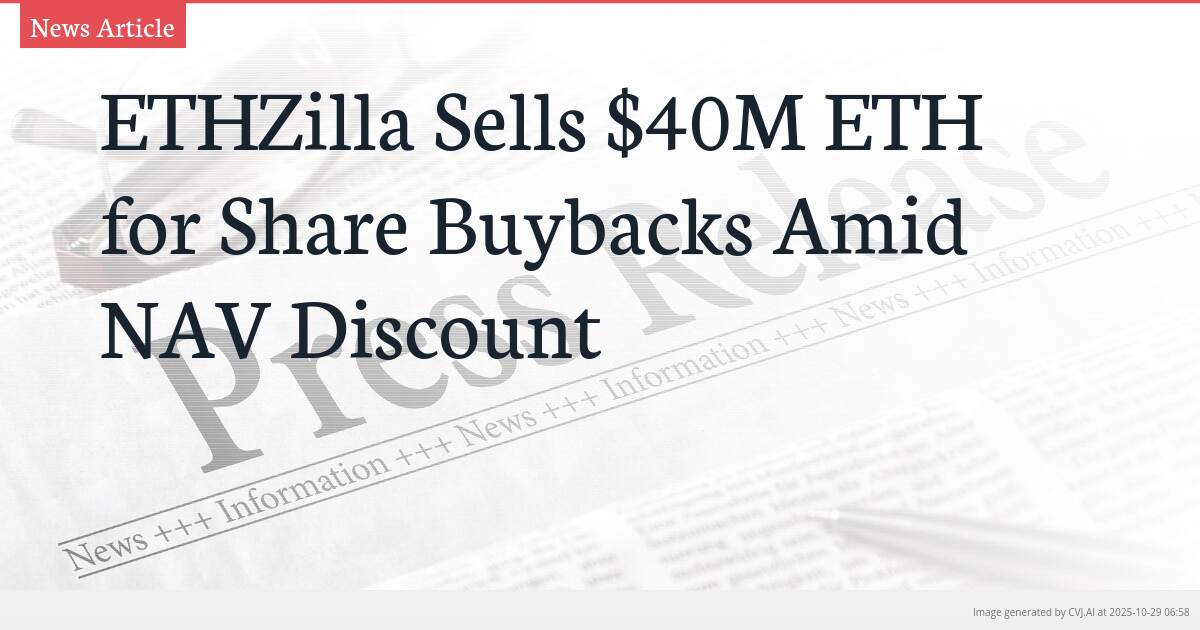This summary text is fully AI-generated and may therefore contain errors or be incomplete.
Introduction
ETHZilla has ignited controversy in crypto markets by selling $40 million worth of Ethereum to fund aggressive share repurchases, framing the move as strategic balance-sheet arbitrage to close what it calls a ‘significant discount to NAV.’ While company leadership insists this represents rational capital allocation rather than retreat from Ethereum exposure, critics warn the mechanism of selling underlying crypto assets to buy equity could trigger a ‘death spiral’ if replicated across the treasury management sector.
Key Points
- ETHZilla maintains ~$400 million ETH exposure despite $40 million sale, emphasizing continued commitment to Ethereum as core treasury asset
- Company cites 'concentrated short selling' as factor depressing stock price, with buybacks aimed at reducing lendable shares available to short sellers
- Retail investor Dimitri Semenikhin accumulated 2% stake, arguing market misprices ETHZilla due to legacy biotech financials obscuring digital asset transformation
The Buyback Strategy: Balance-Sheet Arbitrage or Capitulation?
ETHZilla’s recent financial maneuvers reveal a company attempting to navigate the complex relationship between cryptocurrency holdings and traditional equity markets. According to company disclosures, since Friday, October 24, ETHZilla has bought back approximately 600,000 common shares for $12 million under a broader $250 million authorization program. The company sold roughly $40 million worth of ether to fund these ongoing repurchases, explicitly targeting what chairman and CEO McAndrew Rudisill described as a ‘significant discount to NAV.’
The company has framed these transactions as balance-sheet arbitrage rather than a strategic retreat from its core Ethereum exposure. ‘We are leveraging the strength of our balance sheet, including reducing our ETH holdings, to execute share repurchases,’ Rudisill stated, emphasizing that ETH sales are being used as ‘cash’ while common shares trade below net asset value. He argued these transactions would be ‘immediately accretive to remaining shareholders’ through increased NAV per share.
ETHZilla’s messaging on social media platform X reinforced this narrative, stating the company would ‘use its strong balance sheet to support shareholders through buybacks, reduce shares available for short borrow, [and] drive up NAV per share.’ The company highlighted that it still maintains ‘~$400 million of ETH’ on its balance sheet and carries ‘no net debt,’ suggesting continued commitment to Ethereum despite the recent sales.
Market Skepticism and the 'Death Spiral' Warning
The market reaction to ETHZilla’s strategy has been decidedly mixed, with prominent voices in the crypto community expressing significant concern. Popular crypto trader SalsaTekila commented on X: ‘This is extremely bearish, especially if it invites similar behavior. ETH treasuries are not Saylor; they haven’t shown diamond-hand will. If treasury companies start dumping the coin to buy shares, it’s a death spiral setup.’ This sentiment reflects broader anxiety about the precedent being set by using cryptocurrency reserves to defend equity prices.
Analyst Dan Smith raised fundamental questions about ETHZilla’s funding choices, noting: ‘I am mostly curious why the company chose to sell ETH and not use the $569m in cash they had on the balance sheet last month.’ Smith observed that ETHZilla had just confirmed it still holds about $400 million of ETH, meaning the company didn’t deploy its substantial cash reserves for fresh ETH accumulation. His question—’Why not just use cash?’—cuts to the core of treasury signaling concerns within the crypto investment community.
The skepticism centers on whether using ETH as a liquidity reservoir to defend a discounted equity represents rational capital allocation or capitulation that undermines the ETH-as-reserve narrative. The market-structure logic may be straightforward—buying back stock with ‘coin-cash’ can theoretically collapse the discount and lift NAV per share—but the optics remain contentious because the mechanism requires selling the underlying asset that investors originally sought exposure to through the company’s equity.
Retail Interest and Market Structure Dynamics
Beyond the institutional debate, a retail-driven storyline has rapidly formed around ETHZilla stock. Business Insider reported that Dimitri Semenikhin—who recently became the face of the Beyond Meat surge—has targeted ETHZilla, purchasing roughly 2% of the company at what he views as a 50% discount to modified NAV. Semenikhin has argued that the market is misreading ETHZilla’s balance sheet because it still reflects legacy biotech results rather than the current digital-asset treasury model.
The same report cites liquid holdings on the order of 102,300 ETH and roughly $560 million in cash, translating to about $62 per share in liquid assets. Semenikhin specifically flagged November 13 as a potential catalyst if results show the pivot to ETH generating profits. He also called out a 1-for-10 reverse split on October 15 that, in his view, ‘muddied the optics for retail’ investors trying to understand the company’s true valuation.
ETHZilla’s own messaging has emphasized the discount-to-NAV lens rather than any fundamental change in strategy. The company told investors it would keep buying while the stock trades below asset value and highlighted a goal of shrinking lendable supply to blunt short-selling pressure, specifically citing ‘recent, concentrated short selling’ as a factor keeping the stock under pressure.
Broader Implications for Crypto Treasury Management
For Ethereum markets specifically, the immediate flow effect of ETHZilla’s $40 million ETH sale is limited—representing only marginal impact in ETH’s daily liquidity. However, the second-order risk flagged by traders is behavioral contagion across the crypto treasury management sector. If other ETH-heavy treasuries follow ETHZilla’s playbook—selling underlying Ethereum to buy their own discounted stock—the collective flow could become pro-cyclical and self-reinforcing.
This creates what skeptics describe as a potential ‘death spiral’ scenario: coins are sold to close equity discounts, the selling pressures spot prices, wider discounts reappear as equity screens rerate to weaker marks, prompting further coin sales. The dynamic becomes particularly problematic when the treasury asset—in this case, Ethereum—doubles as the company’s primary signal of conviction to investors.
At press time, ETH traded at $4,156, with market participants closely watching whether ETHZilla’s balance-sheet arbitrage strategy will successfully close its NAV discount or instead validate critics’ concerns about the fundamental stability of crypto treasury management models that rely on selling core assets to support equity valuations.
📎 Read the original article on newsbtc.com

